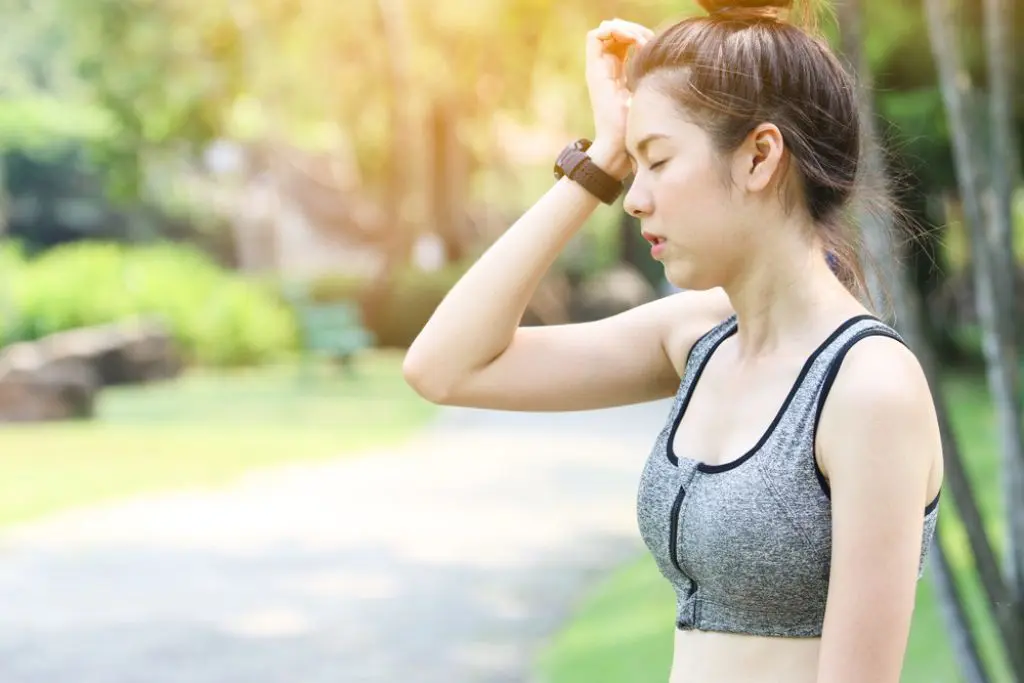Why Do You Get A Headache After Working Out?

June 15, 2023

The feel-good factor is what motivates many of us to get up, move and work up a Sweat, but there’s one common exercise experience which can quickly derail your feel-good vibes, and that’s getting a headache after working out (or right in the middle of your session!).
Workout-induced headaches are common and usually nothing to worry about, but there are a few things it pays to know in terms of preventing them or when to see your healthcare provider.
What is an exertion headache?
Headaches from exercise, aka exertion headaches, involve head pain during or after physical activity and can last anywhere from a few minutes to 48 hours, according to Cleveland Clinic. While strenuous physical activity is often to blame, exertion headaches can also be caused by coughing, sneezing or straining during bowel movements.
An exertion headache is commonly described as being a pulsing pain on both sides of the head, says the American Migraine Foundation, and although the exact cause is unknown, theories suggest headaches after exercise could be related to changes to your blood vessels, circulation or muscle strain.
Headaches from exercise: When to see a doctor
If a post-workout headache only happens once in a blue moon, it’s probably nothing to worry about and could be the result of simply pushing yourself too hard, or factors like dehydration, a lack of food or overheating (more on these later!). In this case, your headache is referred to as a primary exercise headache, where exercise is the main cause.
However, if your exertional headaches are happening regularly or are extremely painful, it’s best to see your healthcare professional for advice. For regular primary exercise headaches, your healthcare professional may prescribe anti-inflammatory medication, but they also may run additional tests to make sure you’re not experiencing a secondary exercise headache, meaning the pain is caused by something else.
Likewise, if your workout headaches are accompanied by other symptoms such as vision problems, vomiting or neck stiffness, always get yourself checked.

Tips to prevent exertion headaches
In the case of primary exercise headaches, there are a few things Cleveland Clinic and the American Migraine Foundation recommend you can try to reduce your chances of getting one.
1. Stay hydrated
Dehydration is a common culprit when it comes to headaches of any kind, so you’ll be doing yourself a favour by keeping your body hydrated. Try to drink plenty of water during the day, take small sips when you need during your workout, and make sure you rehydrate post-workout, too. Aiming for at least two litres of water per day is a good general hydration target!
2. Make time for a warm-up and cool-down
Going from zero to 100 real fast when you start your workouts isn’t wise for many reasons. You want to prioritise your warm-up to prepare your muscles, reduce your risk of injury, and slowly increase your heart rate and circulation.
Doing some light cardio for five minutes, alongside some dynamic stretches, is a great way to prepare your body for the movement to come. This is especially important if you’re about to do a strenuous workout such as HIIT, heavy lifting or running.
At the end of your workout, gradually bring your body back to its baseline with another few minutes of light cardio and some static stretches.
The concept of easing into it doesn’t just apply to individual workouts but should also be applied to your entire training program, with the American Headache Foundation adding that warming up before exercising and increasing your workout intensity and length over a period of months may prevent primary exercise headaches from occurring!
3. Fuel your body
Having an empty tank can definitely set you up for a pulsing exercise headache. Aim to eat a substantial meal or a pre-workout snack containing carbohydrates a few hours before your Sweat session, or make sure you eat enough at dinnertime if you prefer to work out on an empty stomach first thing in the morning.
When low blood sugar is a contributing factor, your post-workout headache may be accompanied by a feeling of weakness, shakiness or dizziness.
4. Stay cool
Increasing your body temperature is a natural part of exercising, but working out in soaring temperatures can set you up for a headache or even heatstroke, as can working out after spending too much time in the sun.
Try to schedule your training sessions for cooler times of day or seek out shaded or air conditioned spaces. If you feel yourself overheating, take a break, get yourself to a cooler area and have some water.

5. Check your lighting
For those who have a history of migraines in particular, lighting can be a big contributor to headaches. If you’re exercising outdoors, wearing sunglasses can help, and for indoor workouts, try to avoid harsh, fluorescent or flickering lights.
6. Keep track to find your triggers
If you regularly get a headache after working out and your healthcare provider has ruled out other possible causes, keeping notes on your habits and headache patterns may help you identify what’s triggering it and make changes.
Perhaps you realise your headaches show up on days when you haven’t had much water, enough to eat, are pushing yourself too hard during your workouts or you skipped your warm-up! You might even notice your headaches are specific to a particular exercise or training style.
For example, if jumping movements are triggering headaches, you could switch to a low-impact program such as Low Impact Strength with Kelsey Wells.
7. Good form goes a long way
Here at Sweat, we’re always talking about the importance of mastering your form before increasing your speed or weights, and this isn’t just about correct muscle activation or avoiding injury.
When performed incorrectly, many movements can put extra strain on your neck and shoulders, and tension in this area can lead to headaches. Straining your neck is easy to do during exercises such as bench press, weighted squats, deadlifts, tricep extensions, shoulder press and even cycling. Focus on relaxing the muscles around your neck and shoulders and engaging the area you’re supposed to be working.
8. Make recovery part of your routine
Even if you have impeccable form, it’s still important to include rest days, stretching and techniques such as foam rolling to reduce muscle tightness across your entire body and promote faster recovery. Feeling tense in your shoulders? Try these stretches!
9. Release the pressure
You never want to add tension to your head if exertion headaches are an issue for you, so if you’re wearing any workout headwear such as a sweatband, cap, or goggles for swimming, make sure they aren’t too tight.
Your hairstyle can also make a big difference to the tension or weight on your scalp, so experiment and see what feels best for you.
Feeling sweaty, puffed and energised are common side effects of working out that many of us love, but exertion headaches? Not so much.
See your healthcare provider if your exercise headaches are severe, recurring or accompanied by other symptoms, or follow these handy tips to keep those aches at bay!

A more empowered you starts with Sweat, and our editorial team is here to bring you the latest fitness tips, trainer recommendations, wellbeing news, nutritional advice, nourishing recipes and free workouts.
* Disclaimer: This blog post is not intended to replace the advice of a medical professional. The above information should not be used to diagnose, treat, or prevent any disease or medical condition. Please consult your doctor before making any changes to your diet, sleep methods, daily activity, or fitness routine. Sweat assumes no responsibility for any personal injury or damage sustained by any recommendations, opinions, or advice given in this article.
Wellbeing